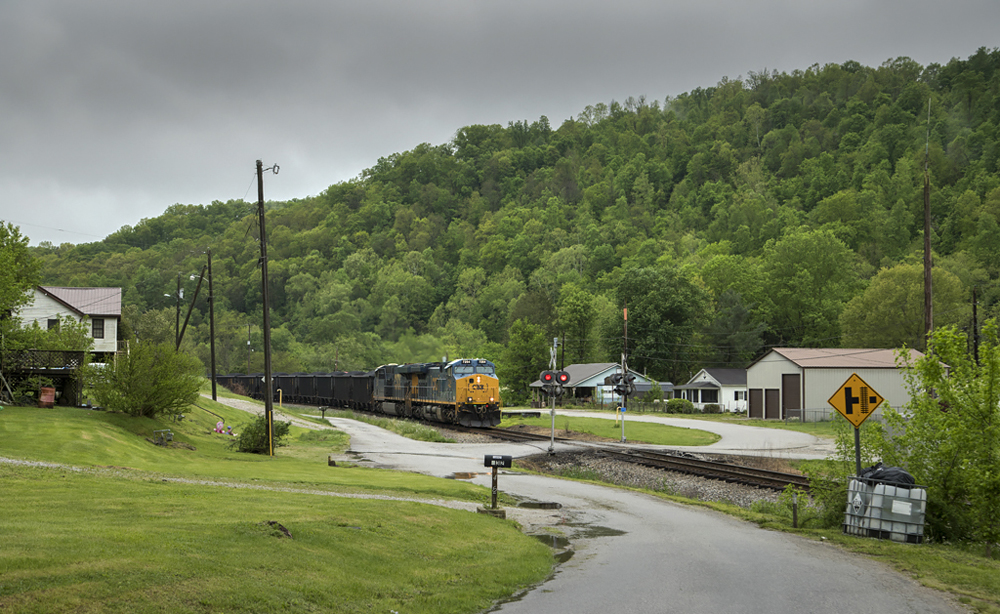
CHARLESTON, W.Va. — American coal prices in the aftermath of the coronavirus have reached unprecedented highs and world events are notching prices even higher [see “Russia-Ukraine war likely to bolster U.S. coal imports,” Trains News Wire, March 28, 2022].
While coal supply remains tight, continued favorable pricing may increase mining-company confidence to tap into reserves made cost-effective by today’s spot-market prices, potentially leading to new railroad opportunities.
Coal prices continue reaching new highs in most markets. Powder River Basin coal has receded from its December 2021 peak but is still $3 higher per ton than 10-year averages. Compared to the same period a year ago, spot prices per short ton of Illinois Basin coal are up a staggering 255%; Central Appalachia up 110%; Northern Appalachia up 84%, Powder River Basin up 28%; and Uinta Basin up 22%.
U.S. railroads have hauled more than 1.1 million coal carloads through May 7, according to Association of American Railroads data, a near 7% increase year-over-year. Year to date, Union Pacific’s coal traffic is up 24% and BNSF Railway’s is up 8%. In the East, CSX’s coal business is down 6% and Norfolk Southern’s is down almost 3% year-over-year.
Coal buyers who are hungry for more tons and have the flexibility to choose from a pool of suppliers may now be looking at U.S. locations where American coal companies have the workforce and capacity to beef up production and tap into reserves that might have previously been cost prohibitive, solidifying America’s relevance as an important global swing supplier. Such was the case shortly after the onset of the coronavirus when China started buying U.S. coal instead of Australia [see “China’s ban on Australian coal is benefiting U.S. railroads,” News Wire, Nov. 24, 2021].
The European Union’s decision to ban Russian coal imports after mid-August may allow the U.S. to bolster exports to European countries in the second half of the year. Tight supply and ongoing world events may extend coal’s post-pandemic renaissance through the balance of 2022; many analysts had expected demand to wane mid-year prior to Russia’s invasion on Ukraine.
High natural gas prices are another factor that may strengthen coal’s case. Henry Hub natural gas spot prices, the benchmark for the North American natural gas market, were $6.60 per million BTU in April, the highest in nearly 14 years. Coal typically becomes more competitive with natural gas when its price averages above $3 per million BTU.
The U.S. Energy Information Administration forecasts in its latest coal outlook that coal production will rise 3% in 2022 and those tons will be used to replenish stockpiles at power plants as well as support coal exports as a result of high global coal prices. The agency does note that labor issues, rail congestion, and equipment challenges may hold-back those production gains.
Coal miners’ ability to add capacity and capture spot market opportunities with partners, like railroads, will allow the sector to seize ancillary business during a time of extreme uncertainty and volatility. These conditions may help boost carloads in coal country’s most under-utilized places.














Coal is done for in the US, as it should be. I’m not sure that even a GOP President (What, me worry? I don’t feel hot) will be able to reverse its decline.
Coal is the only energy source that can be easily stockpiled at its destination, others cannot. It will not serve as the day-in, day-out backbone fuel of choice, but will be relied upon when dams are low or gas supplies are interrupted.
The problem is all those stockpiles are low right now because railroads have been in a “can’t deliver” cycle without hurting investors who don’t work for a living.
Hey Peter, I am an investor, a retired railroad employee, and I have always worked for a living. I imagine you were referring to the financial Wall Street types. I believe those Wall Street people also work for a living. My investments have done well and lately have not done so well. I follow the news of the railroad industry. It has often been late to react to markets. Kind of like turning around the Titanic before it hits the iceberg.
I am sure he was referring to day traders and hedge fund managers who spend the majority of their time performing predatory trading research to locate opportunities that are detrimental to the markets long term, but generate profits in the short term.
Coal might be “on the way out” for power generation here in the US, but certainly not overseas. China and India alone have dozens of new plants on the drawing board, and the German brain trusts that shut down their clean, non-polluting nukes, are turning back to burning the worst possible grade of coal, dirty-burning lignite. How brilliant, thanks anti-nukers.
right on as usual Al
Natural gas is of course a viable alternative energy source for electricity generation in the U.S., however as noted here, natural gas prices are very high right now. And of course the extreme ‘Green’ environmentalists don’t want natural gas used for electricity generation either.
Not sure the creaky current electrical grid in the U.S. is going to be able handle the surge in infrastructure demand to power all the new electric cars and so forth.
Yes, blackouts in California and elsewhere are inevitable …. (might be a long, hot summer …).
At least the railroads will get a short term traffic “bump” from the increase in coal traffic for exports. Hope their “PSR” business model doesn’t screw it up ….
Coal is still on the way out, regardless of this small bump. Coal is a dirty energy source, polluting our air, destroying our landscapes, and giving generations of miners Black Lung disease. The sooner we move away from coal for electricity generation, while providing jobs for those affected by the shift, the better.
No thanks for the climate change writers’ press release talking points, and concentrate on getting some education based on economic reality
The problem with green energy is that it requires huge amounts of raw materials – iron ore, lithium, copper, rare earths. This will require developing a lot of new mines which will not be much of an environmental improvement. The IEA (in Geneva) last year, in between begging for more green energy sources, pointed out that it was going to be almost impossible to mine all these materials in between NIMBY’s, environmentalists, government regulators, and the lack of known resources (copper is already in short supply).
I wonder how long this will last. The global warming cult is forcing utilities to close coal plants in favor of unreliable solar and wind facilities. This won’t change until we have massive blackouts (California for starters) and voters force politicians to start thinking rationally about reliable electric power. The push for electric cars will further overload the electric grid but that again is something the utility regulators don’t think about. On the other hand we may wind up like Germany whose catastrophic energy policies (even before the Ukraine invasion) have Germany consuming more and more coal.